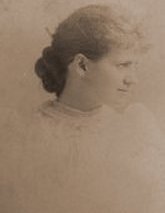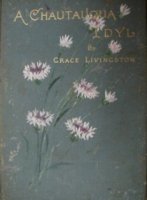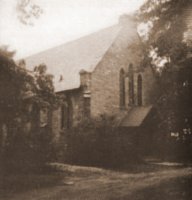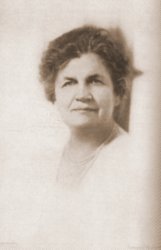



April 16, 1865: Grace Livingston Hill is born in Wellsville, New York to Marcia Macdonald Livingston (Mrs. C M Livingston, an author) and the Reverend Charles Montgomery Livingston, a Presbyterian minister. Grace was their second child; her older brother Percy, born in 1863, died in infancy. (He only lived one day.)
April 16, 1877: The Esselstynes, or, Alphonso and Marguerite is published. (Grace's first book) Grace's "Auntie Belle" (aka Isabella Macdonald Alden, Mrs. G R Alden, Pansy, author of the Pansy books) presents her with, The Esselstynes, as a surprise on Grace's 12th birthday. The Esselstynes was a book that consisted of a recited story told by Grace herself. It was informally published by "Auntie Belle" by D. Lothrop Company who was also later used by Grace for publishing other manuscripts.

1860's-1885: Grace was taught at home before she began attending public school. She was a quick learner. She enjoyed amusing herself happily for hours with pencil, paper, books and crayons... She showed an early talent for drawing, and sometimes as a child did blackboard sketches when on lectures with her Aunt Isabella. Painting became a hobby she enjoyed all her life. She also enjoyed watching her aunt write, and reading her stories page by page as they were typed. She loved horseback riding and often played tennis with her father on their homemade court. As she grew older, she often played chess with her father. Her family enjoyed reading aloud each evening, following an hour of worship. They read the works of George Macdonald, Dickens... classics such as Jane Eyre, and many others. Grace also often read aloud to her father who suffered from eyestrain. She often visited other churches with her father and helped with Sunday School, played the organ, and would sing at those churches sometimes. When growing up, between the years of 1876 and 1892 Grace and her parents lived in at least 9 different parsonages. They moved from Watertown, NY, to Greensburg, Indiana, to Cincinnati to Cleveland to Orange, New Jersey, to Campbell, New York, to Sorrento, Florida, to Winter Park, Florida, to Hyattsville, Maryland. Some of the parsonages were cheerless and discouraging and despite valiant efforts to brighten them with homey little touches often nothing could be done to compensate for cramped quarters. Grace found escape in daydreams of lovely spacious homes, and when she was older she had her home in Swarthmore built. Grace goes to Elmira College, but doesn't like being away from her family, so she returns home after only one term. Later she goes to Cincinnati Art School to study art, but again becomes homesick so she returns home.

Summer of 1886: Grace and her family move to Winter Park, Florida after Charles requests to be transferred to a new church due to his health. Grace begins volunteering at her father's church as a secretary.
November of 1886: Grace begins writing her first book, A Chautauqua Idyl. She intends to write the book to raise the money to go to Chautauqua, New York in the summer, since her family can't afford to go as they have in the past.
December of 1886: Grace finishes her manuscript. She sends it off to D. Lothrop Company.
January of 1887: Her book is accepted by the publishing company with good reviews.
Spring - Summer 1887: Her first book, A Chautauqua Idyl is published in time to be on sale during Chautauqua for 60 cents.

1887: Meets Frederick Starr Ph. D. who joins the faculty at Rollins College. They become very good friends.
1888: Pansies for Thoughts is published. Pansies for Thoughts was a book written in honor of her Aunt Isabella. Grace took quotes from her aunt's Pansy books and coupled them with scriptures from the Bible, one for each day of the year, so this book is a Christian devotional, rather than a fiction novel, like many of her later books.
May 1889: Grace gets a job as a physical education director. She was the leader in calisthenics and heavy gymnastics at Rollins College.
1890: A Little Servant is published.
Summer 1890: Grace meets Reverend Thomas Guthrie Franklin ("Frank") Hill at Chautauqua. Dr. Frederick Starr is also there. Frank Hill was a Presbyterian minister at a church near Pittsburg, Pennsylvania. Grace begins writing to him after leaving Chautauqua.
Summer 1891: Sees Frank at Chautauqua again. Grace also spends time with Frederick there but only considers him a good friend. She feels it was more than friendship to Frederick, so she suggests they not spend as much time together at Chautauqua.
September 1891: Frederick proposes, but Grace rejects his proposal. (He never married)
Fall 1891: Grace moves to Hyattsville, Maryland (near Washington, D.C.) with her family when her father is called to another church. Grace finishes The Parkerstown Delegate, while on the train from Florida to Hyattsville. Frank visits almost at once, he was working on post graduate studies at Princeton.
1892: The Parkerstown Delegate, A Christian Endeavor Story is published.
Summer 1892: Frank proposes and a week later gives Grace an engagement ring at Chautauqua where they announce their formal engagement.


December 2, 1892: Grace marries Frank Hill, at Hyattsville Presbyterian Church (Her father's church... Her father conducted the ceremony). They go to Baltimore for their honeymoon, then go to western Pennsylvania to return to Frank's pastorate. Her wedding dress was new, white satin, with real white flowers on the veil and she had lilies of the valley in her bouquet.
December 1892: Grace notices a few days after her the wedding that Frank seems to have emotional mood swings. He tells Grace that when he was in university in Scotland he had terrible headaches and the doctor prescribed medicine that helped, but he became addicted, not knowing the danger of addiction. He tried in many ways to stop, he prayed about it, but couldn't stop. They kept this between the two of them - his father knew and possibly his mother. Even their children didn't know til 25 years or more after his death.
Early 1893: Grace and Frank move within 4 months of moving into their first home when Frank is transferred to a larger church (Wakefield Presbyterian Church in Germantown, Pennsylvania) They lived there for about 7 years. Squeezed in between housework; magazine articles and Sunday School lessons flowed out in an ever widening stream. Even when pregrant with her first child she didn't slow down her quest for new outlets for her writings.
September 17, 1893: Frank's and Grace's first child, Margaret Livingston Hill is born.
1895: Katharine's Yesterday and Other Christian Endeavor Stories is published.
1897: In the Way is published.

1898: Lone Point: A Summer Outing is published.
January 24, 1898: Frank's and Grace's second child, Ruth Glover Hill (aka Ruth Livingston Hill) is born.
Summer of 1899: Frank becomes ill with appendicitis, but his doctor discourages surgery due to the dangerous risks. Frank still preaches most Sundays, but by November he was so sick that the doctor advises surgery, which was performed on November 18th.
November 22, 1899: Frank dies from appendicitis, after a surgical attempt to save his life. Grace took the loss very hard. The funeral was held at Wakefield Church.
1899: Grace and her two daughters move to Swarthmore, Pennsylvania. Grace has to find a new home, because the home she lived in belonged to the church. Grace's parents had come to be with her when Frank was going to have surgery and Grace's mother stayed until Grace found a place to live. She found a small brick house to rent on Harvard Avenue in Swarthmore. Grace often spent nights writing. She needed a job (writing) where she could be home with her children.

February 1900: A Daily Rate is published.
July 6, 1900: Grace's father Charles dies. Soon after his death, Grace's mother Marcia moves to Swarthmore to live with Grace.
Early 1900's: Grace's mother helped her with teaching and raising the girls. (Ruth and Margaret were both taught at home for several years.) Grace continues writing stories for Christian Endeavor World, the American Sunday School Union, Golden Rule Press, The Washington Star, (She had a syndicated column - a Sunday School lesson - published weekly), etc. Grace also spends a lot of time working in the Swarthmore Presbyterian Church in women's groups and Sunday School. Grace was involved in 4 churches during her time in Swarthmore... Swarthmore Presbyterian, Third Presbyterian in Chester, Pennsylvania, the Leiperville Church in Leiperville, Pennsylvania and the Blue Church in Swarthmore. She was involved in the Swarthmore Presbyterian Church immediately after moving after Frank died. She taught junior classes in Sunday School and directed a Christian Endeavor Society. Ruth and Margaret were very involved in these churches also.
1902: The Angel of His Presence is published.
1902: An Unwilling Guest is published.
1903: The Story of a Whim is published.
1903: According to the Pattern is published.
1903: Grace meets Flavius Josephus Lutz, the minister of music at her church, Swarthmore Presbyterian. A friendship develops between them. Although Grace didn't play a musical instrument she started her daughters on music lessons at age five. Margaret had been studying piano for 5 years and Ruth for 6 months... F.J. showed a keen interest and gave helpful advice.
1903/04: Grace decides to try writing a western since they were popular at the time, so she begins writing The Girl from Montana
1904: Because of Stephen is published. Around this time Grace begins planning to change her style of writing to appeal to non Christians as well as Christians, but to have a clear gospel message in all of her books.

1904: Grace had a modest house built on the lot she had bought on Cornell Avenue in Swarthmore...at first it was a small stone house, but over time it was remodeled and grew to be 14 rooms. Grace wrote many of her books in her bedroom study in this house. The study was a pleasant room... the door was usually open and family was always welcome to enter without fear of disturbing her.
1904: Flavius Josephus Lutz proposes. She asks for time to think it over... Family and friends advised her not to marry him, but it seemed right - a husband, father and music teacher for her daughters, and a person who loved beauty as much as she did. She decides to accept his proposal.
October 31st., 1904 Grace marries Flavius Josephus Lutz.
Early 1900's: Her books soon begin to be published under the name Grace Livingston Hill-Lutz... Flavius was vehement that since she was Mrs. Lutz she shouldn't be ashamed to put it on her books. Grace gave in to please her husband and she wrote under that name for several years. Within a few weeks life became strained. F.J. took no leadership role in the home, contributed nothing to the running of the household, had little work to do and didn't seem to know how to go about getting a job. Grace organized a music school for him, and let people know her husband taught music. The house was used as a music studio as well as a home and writer's study. Still he never contributed to household expenses.
1906: Grace enrolls the girls in school. Margaret started 6th grade, Ruth started 2nd grade. When the girls were growing up, she was always busy, cooking, cleaning, tending the lawn and working in her garden, and she made all of the girls clothing. Her daughters were now old enough to be interested in her books, and they often stood behind Grace as she typed when they returned home so they could read as the story was written. As the girls got older, they often read her manuscripts, suggesting changes, but usually little rewriting was done. Grace's mother often read her stories and offered suggestions also.
1908: The Girl from Montana is published.
1908: The first draft of Marcia Schuyler is written within 5 weeks. She takes it to J. B. Lippincott Company and changes publishers at this time. The first editions of most of her books after this were published by Lippincott.
1908: Marcia Schuyler is published.
1909: Phoebe Deane is published.

1910: Dawn of the Morning is published.
1911: Aunt Crete's Emancipation is published.
1912: The Mystery of Mary is published.
1913: Lo, Michael is published.
1914: The Best Man is published.
1914: The Man of the Desert is published.

May 1914: Flavius Josephus Lutz leaves. Shortly after their marriage he began to criticize everyone and enjoyed fighting/arguing with the family. He was very unkind and abusive with words. Grace knew she had made a terrible mistake, but divorce never entered her mind... she had made a lifetime commitment before God and felt strongly she should keep it. She tried to create a happy atmosphere for the family and at times Lutz could be charming. The whole family would have fun together. One day Lutz left the house and didn't return that night. Grace finally located him at his parents house. He returned home the next day. This pattern continued and then he began missing Sunday morning services where he was supposed to play the organ - Margaret had to fill in for him. He always went to his parents house. After a particularly long time away, Grace with much thought and prayer told him "Please don't come back". She hoped he would ask forgivness or make a positive response but he seemed relieved. He only returned for a visit or two after that, and left in 1914. Eventually the marriage was annulled.
1914: Ruth graduates from high school.


Early to mid 1910's: Ruth and Margaret were busy with the music school they had both been involved in since their early teens and both were studying music privately. The music school was eventually moved out of the house and into it's own building at Haverford and Harvard Avenues. Margaret was the director and Ruth head of the violin department. Ruth and Margaret both attend Swarthmore College. Ruth becomes close friends with Thaddeus Rich "Gordon" Munce at Swarthmore College and the relationship developed into a romance over a period of several years. (Gordon's family lived a few blocks away and he had known Ruth and Margaret since their days in Christian Endeavor Society.) Gordon is sent to the French front to fight the Germans.
1915: Miranda is published.
1915: The Obsession of Victoria Gracen is published.
1916: The Finding of Jasper Holt is published.
1916: A Voice in the Wilderness is published.
1917: The Witness is published.
Mid to late 1910's: Around this time, Grace took her books to another publisher due to Lippincott not being receptive to the religious tone. Some books were then published by Fleming H. Revell Company and others by Harper and Brothers. The Witness published by Harper and Brothers was Hill's most widely read book. The enthusiastic response to The Witness convinced Lippincott of its error, so from that time on they published whatever she wrote without making suggestions or alterations.
1918: The Enchanted Barn is published.
January 27th., 1919: "The Enchanted Barn" is released as a movie.
May 4th., 1919: "The Best Man" is released as a movie.
1919: The Red Signal is published.
1919: The War Romance of the Salvation Army is published. This was Grace's second non-fiction book, which was co-authored by Evangeline Booth.
1919: The Search is published.
1920's: Ruth marries Gordon Munce when he returns home from France. They move away to a house a few miles away, although Grace wants everyone to live with her. A year later Ruth becomes ill and needs nursing care. At Grace's urging Gordon and Ruth move back into Grace's home. The same year Grace's mother, Marcia dies at the age of 93. The following year Margaret marries Wendell H. Walker and they also live with Grace. Two years later the Walkers decide to move into their own home. Ruth and Gordon continue living with Grace. Ruth wanted their own home, but Gordon felt they should stay with Grace - that she needed them.

One day when having additions done to her house an Italian stonemason asked if she and her daughters would put on a little concert for the Italian community in Avondale near Wallingford... After the concert Grace asked the parents if they would be willing for her to come and teach their children a Sunday School lesson each Sunday. She rented an upstairs room in an empty shop in Avondale, but eventually the Sunday School expanded so some of the men asked if Grace would be willing to move the Sunday School to the old Presbyterian church in Leiperville which had been closed for several years. When the church re-opened, soon a large number of children and adults began attending. Grace's involvement in the church and the Italian community lasted for more than 25 years and ended only when she died. She started English classes, Sunday School, a Bible Study... and helped to pay the bills whenever there was a shortfall in finances at the little church.

Over the years Grace spoke at hundreds of Churches, Public Conference Centers, Sunday Schools, Bible Institutes, etc. and continued her speaking engagements up until she was 79 years old. During lectures she never accepted payment, because her income as a novelist was as she described it "quite adequate for my needs..." She only accepted free will offerings for donation to the Old Leiper Church or to help with travel expenses.
Grace received many letters over the years and replied to all letters. Ruth and Margaret helped reply to some of these, and then later she had a secretary for 8 years, Robert Cressy who later became pastor at Blue Church in Swarthmore.
1920: Cloudy Jewel is published.
1920: Exit Betty is published.
1921: The Tryst is published.
1922: The City of Fire is published.
1923: The Big Blue Soldier is published.
1923: Tomorrow About This Time is published.
1924: Re-Creations is published.
March 29th., 1925: The movie "Marriage in Transit" is released and is based on Grace's book, The Best Man. (The second time The Best Man was made into a movie.)
1925: Not Under the Law is published.
1925: Ariel Custer is published.



1926: A New Name is published.
1926: Coming Through the Rye is published.
1927: Job's Niece is published.
1927: The White Flower is published.
1927: The Honor Girl is published. This book was written under the pen name Marcia Macdonald.
1928: Crimson Roses is published.
1928: Blue Ruin is published.
1928: Found Treasure is published. This book was written under the pen name Marcia Macdonald.
1929: Duskin is published.
1929: The Prodigal Girl is published.
1929: Out of the Storm is published. This book was written under the pen name Marcia Macdonald.

1930's Margaret and Wendell take an assignment with the Home Mission Board of the Southern Presbyterian Church to do home mission work in the rural areas of Kentucky, but they returned home for visits. Wendell conducts a Bible school for the mountain people of Kentucky and West Virginia.
After several years Gordon who worked for a large oil company was transferred to Virginia. The transfer lasted for 2 years. Margaret and Wendell's son Allyn was now of college age and had come to live with Grace during his last two college years. About the time he graduated from college, Ruth and Gordon returned. Ruth and Gordon lived with Grace for the rest of her life. Grace had 4 grandchildren who called her Baba. (when Allyn was young he called her this and the name stuck) Margaret had 2 children - Allyn who became a pastor and Marcia who spent many years in Taiwan with her husband, serving God. Gordon and Ruth adopted 2 children. Their first child Gordon became an accountant and was active in his church. Their second child Robert was a missionary in Africa for a number of years then developed a Christian literature distribution system to supply inexpensive Bibles and Christian books to the poorer countries of the world. He later wrote a biography about Grace.

Grace enjoyed reading books by contemporary fiction writers. She subscribed to 12 magazines and enjoyed both short stories and novels that appeared serially, especially the stories of Kathleen Norris and Temple Bailey whom she greatly admired. She also enjoyed listening to the radio, but was too busy to be a regular listener. She enjoyed listening to news broadcasts, commentators, and good music programs like Kate Smith and the Reverend Daniel Poling. She didn't attend movies and was unrelenting in her critcism of the evil ends being served by this important medium which she felt could have been used for more constructive purposes. She also enjoyed spending time working in her old fashioned flower garden.
1930: Ladybird is published.
1930: The Gold Shoe is published.
1930: The White Lady is published. This book was written under the pen name Marcia Macdonald.
August 5, 1930: Grace's Aunt Isabella dies.
1931: Silver Wings is published.
1931: The Chance of a Lifetime is published.
1931: Kerry (1931) is published.
1931: Memories of Yesterday is published. (Autobiography of Isabella Alden, edited by Grace)
1932: Happiness Hill is published.
1932: The Challengers is published.
1932: The Patch of Blue is published.



1932: J. B. Lippincott begins publishing some of her short stories in book form. The four books published in 1932 were Beggarman, The House Across the Hedge, The Story of the Lost Star, and Her Wedding Garment. These were republished in short story collections later.
1933: The Ransom is published.
1933: Matched Pearls is published. This book was considered by Ruth to be the best novel written by her mother.
1933: The Beloved Stranger is published.
1934: Rainbow Cottage is published.
1934: Amorelle is published.
1934: The Christmas Bride is published.
1935: Beauty for Ashes is published.
1935: White Orchids is published.
1935: The Strange Proposal is published.
1935: J. B. Lippincott publishes 4 more of Grace's short stories in book form. (The 4 books were The Handmaid of the Lord, The Old Guard, The Strange God, and Life Out of Death These were republished in short story collections later.
1936: April Gold is published.
1936: Mystery Flowers is published.

1936: The Substitute Guest is published.
1937: Sunrise is published.
1937: Daphne Deane is published.
1937: Brentwood is published.
1938: Marigold is published.
1938: Homing is published.
1938: Maris is published
1938: J. B. Lippincott publishes 5 more of Grace's short stories in book form. (The 5 books were The Best Birthday, The Lost Message, The Minister's Son, The Divided Battle, and Dwelling. Some of these were republished in short story collections later.
1939: Patricia is published.
1939: The Seventh Hour is published.
1939: Stranger Within the Gates is published.
Late 1930's - 1940's: By the end of the 1930's Grace had written 89 volumes. Magazines were still printing her novels in serial form. In the late 1940's she had cancer, yet when she had the strength to get out of bed and type, her memory which was failing would come back in a flood as she would sit at her typewriter. She picked up writing right where she left off for a couple of pages until she ran out of energy and then she would ask for help back into bed. She typed fast, but could only write a little at a time and then had to rest.


1940: Head of the House is published.
1940: Rose Galbraith is published.
1940: Partners is published.
1941: By Way of the Silverthorns is published.
1941: In Tune with Wedding Bells is published.
1941: Astra is published.
1942: The Girl of the Woods is published.
1942: Crimson Mountain is published.
1942: The Street of the City is published.
1943: Sound of the Trumpet is published.
1943: Spice Box is published.
1943: Through These Fires is published.
1944: More Than Conqueror is published.
1944: Time of the Singing of Birds is published.
1945: All Through the Night is published.
1945: A Girl to Come Home To is published.
1946: Bright Arrows is published.
Fall 1946: Grace's health begins to fail visibly. She had had a serious operation that sapped her remaining strength.
1947: Where Two Ways Met is published.

February 23, 1947: Grace Livingston Hill dies at age 82. Funeral services were held at the Tenth Presbyterian Church in Philadelphia and conducted by the Reverend William Allan Dean and the Reverend Robert A. Cressy. (who had served as her secretary for 8 years) Grace was buried in Jamestown, New York, for interment in the Livingston family burial plot. Cause of death given was "a general breakdown due to her advanced years and to having worked hard."
1948: Mary Arden is published. Ruth Livingston Hill finished this book after Grace's death.
1948: Grace Livingston Hill Her Story and Her Writings by Jean Karr is published. This is the first of three biographies about Grace.
1948: Ruth was now living in Florida after the recent death of her husband. At that point Ruth's main interest was teaching and she had shown no inclination to pursue a literary career at that time. Margaret wrote for religious publications and wrote juvenile stories... a series of these designed originally for her children were published in The Children's Lamp by Margaret Livingston Hill. (published in 1932)
1949: Miss Lavinia's Call is published.



1976: The Short Stories of Grace Livingston Hill is published. (Includes Beggarman, The House Across the Hedge, The Story of the Lost Star, and Her Wedding Garment).
1981: Grace Livingston Hill: A Checklist - A Bibliographic Guide to the Works of Grace Livingston Hill by Joanna Paulsen is published.
1984: The Honeymoon House and Other Stories is published.
August 1984: The Love Gift and Other Stories is published.
1986: Grace Livingston Hill by Robert Munce is published. (A biography written by Grace's grandson...Ruth's son.)
1988: A Personal Influence is published.
1991: For Each New Day is published. This is a reprint of Pansies for Thoughts, but with a new title. For Each New Day doesn't tell which Pansy books the quotes are from though, unlike Pansies for Thoughts.
1991: Grace Notes Loving Thoughts From Grace Livingston Hill is published. This book is full of inspirational quotes.
1994: The Forgotten Friend and Other Stories is published.
1997 Gracious Writer For God by Betty Steele Everett is published. (This is the third and most recent biography about Grace.)
May 23, 2001: Ruth Livingston Hill Munce dies at the age of 103.





